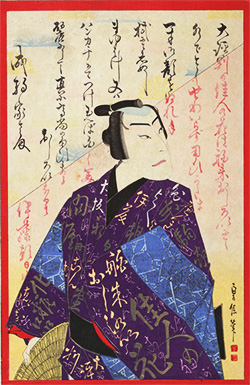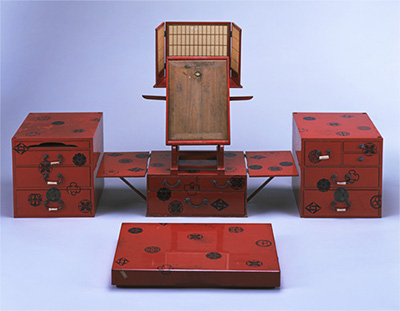
(1) Advertisement for Kajin no Hana cosmetics by Hasegawa Sadanobu II (1898)
Owner: Osaka Museum of History (donated by Imanaka Tominosuke)

(2) The Scene of “The Tea House Kawasho” by Yamaguchi Sohei (1936)
Owner: Osaka Museum of History (donated by Imanaka Tominosuke)
This hanging scroll portrays Ganjiro I performing the role of Kamiya Jihe-e in the scene of “The Tea House Kawasho” in Shinju Ten no Amijima (The Love Suicides at Amijima), Ganjiro’s most successful role. The picture was painted by Yamaguchi Sohei and commissioned by Imanaka Tominosuke, who was a patron of Ganjiro, in commemoration of the 1st anniversary of Ganjiro’s death, and Ganjiro’s crest (i-bishi mon), is placed in the mounting of the hanging scroll. Yamaguchi Sohei is a Japanese painter who painted Ganjiro’s shini-e after his death in 1935. (A shini-e is an obituary picture published to announce the death of a kabuki actor.)

(3) Set of makeup boxes (Meiji period)
Owner: Osaka Museum of History (donated by Sakata Tojuro IV)
This set of makeup boxes had been handed down to Nakamura Ganjiro family members for use in dressing rooms. The red-lacquered boxes decorated with the crests of various kabuki actors, including Ganjiro’s crest (i-bishi mon), are really beautiful. This set is thought to have been handed down to Ganjiro I by his father, Nakamura Kanjaku III, due to the fact that the set is inscribed with the year 1876 and the boxes are decorated with the design of a sparrow in winter and the crest, “翫,” both of which are symbols of Nakamura Kanjaku.


Published as an advertisement insert in the literary magazine Kiraku, this work depicts Ganjiro I performing the role of Fujiya Izaemon in a kabuki play titled Kuruwa Bunsho. This is the scene of Izaemon, disowned by his family, appearing in a pleasure quarter, with the names of cosmetics written on his paper garment. Izaemon, along with Kamiya Jihe-e in the scene of “The Tea House Kawasho,” is included in the Ganjiro Junikyoku (a list of the twelve most successful roles of Ganjiro I).